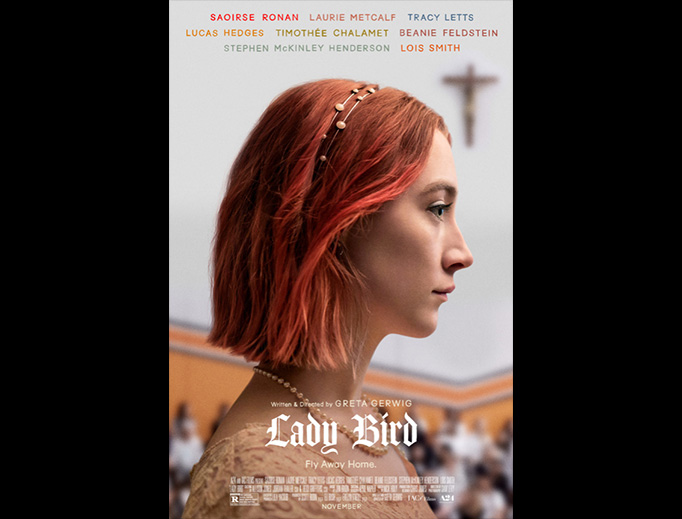‘Lady Bird’ is an Unusual, Hopeful Movie
Lady Bird’s family, with all its limitations, provides a stable loving environment where basic decency is the norm, and redemption is real.

[Editor's Note: This post was updated Dec. 19. Since writing this post, I have read Bishop Robert Barron's column, "Lady Bird and the Breakthrough of Grace," and wanted to bring it to readers' attention. It is well worth reading.]
As an occasionally rebellious teenager, I identified with the zany, self-absorption of the title character in Lady Bird, Greta Gerwig’s engaging new film. The rising high-school senior, played by Saoirse Ronan, casts herself as a trailblazer, even as she exhibits all the contradictory impulses of most youthful rebel-conformists.
As the mother of three adult children, I also embraced the trials and missteps of Lady Bird’s hard-working mother, Marion (Laurie Metcalf), who struggles with a martyr complex. She clearly loves Lady Bird, but doesn’t necessarily like her.
The resolution of this problem, as the teenager struggles to assert her own identity, makes for an unusually appealing film. In fact, Lady Bird made headlines this week after it received 100% favorable reviews on Rotten Tomatoes, breaking a record.
The family lives in Sacramento, California, and Lady Bird, whose given name is “Christine,” hopes to attend a pricy prestigious university across the country, despite her middling academic record and her father’s lack of employment.
But as she plans for the future, Lady Bird must also get through her senior year at her Catholic girls' high school. And viewers who have grown weary of the negative depiction of Catholic women religious, priests and parochial schools, will be pleasantly surprised by the film’s sympathetic treatment of the stable, warm faith-based community that Lady Bird often takes for granted.
For example, in one pivotal scene that sheds light on the conflictive mother-daughter bond, Lady Bird meets with her high school principal, Sister Sarah Joan (Lois Smith), to discuss college plans. The teenager says she wants to get out of Sacramento, but Sister Sarah Joan, referring to Lady Bird’s college application essay, asks her to think twice.
“It’s clear how much you love Sacramento,” she tells the girl.
Lady Bird is taken aback, but finally acknowledges a deep familiarity with the town she frequently disparages.
“I guess I pay attention,” she tells the principal.
This comment offers a fresh way of interpreting mother-daughter combat, and it will resonate with viewers as they absorb the painful barbs and conciliatory language that punctuate the dialogue.
“I want you to be the very best version of yourself,” the mother tells her daughter.
After a lengthy pause, Lady Bird responds: “But what if this is the best version?”
Greta Gerwig helps her audience grapple with the deep, emotional currents that prompt us to wound the people we love.
And Catholics will treasure something else in this unusual film: It offers a palpable sense of hope that spiritual and emotional healing is possible.
Lady Bird’s family, with all its limitations, provides a stable loving environment where basic decency is the norm, and redemption is real.
The predictable rhythms of her high school, from the school Masses, to the tough math class, to the athletic-coach priest who uses football plays to direct students in the upcoming musical, are treated with respect and humor.
One part of Lady Bird wants to break free of this routine. The other part knows she is darn lucky to have a vigilant caring community that tolerates her quirky, occasionally idiotic behavior. This black sheep does go badly astray, and the film is not for children. (It earned an R rating for its language and sexual content.) But she knows there is a safety net. Forgiveness—from the Lord and from her cranky mother—is around the corner.
In contrast, another new film out in theaters now—The Florida Project—presents us with a very different world.
In this movie, a young girl lives in a shabby welfare hotel, and get involved in a series of adventures in the building and in the adjoining neighborhood, located close to Disney World. Her careless mother earns extra cash as a prostitute, and leaves the supervision of her child to the building manager, a rough, yet capable guardian angel.
The Florida Project is hard to sit through, because the viewer remains in constant fear that tragedy is close at hand and this young girl’s jaded kind of innocence will be shattered forever. Lady Bird sends the opposite message, and I wonder if that is why so many viewers loved the movie. Right now, we are starving for happy endings, and Lady Bird promises something like that, although her struggles are far from resolved at the film’s close.
Greta Gerwig also attended a Catholic girls’ high school in Sacramento, though she is not Catholic. That makes this beautiful, painful film about a teenager who wants to be loved unconditionally all the more fascinating.
In contrast to some movies made by religious filmmakers, Lady Bird offers a transcendent vision of life, yet it contains no awkward pietistic elements that can turn off skeptics. Lady Bird offers something different. Nevertheless, like a quirky Flannery O'Connor short story, it marks a life redeemed by the Spirit. The black sheep amongst us will perk up their ears and take notice.













